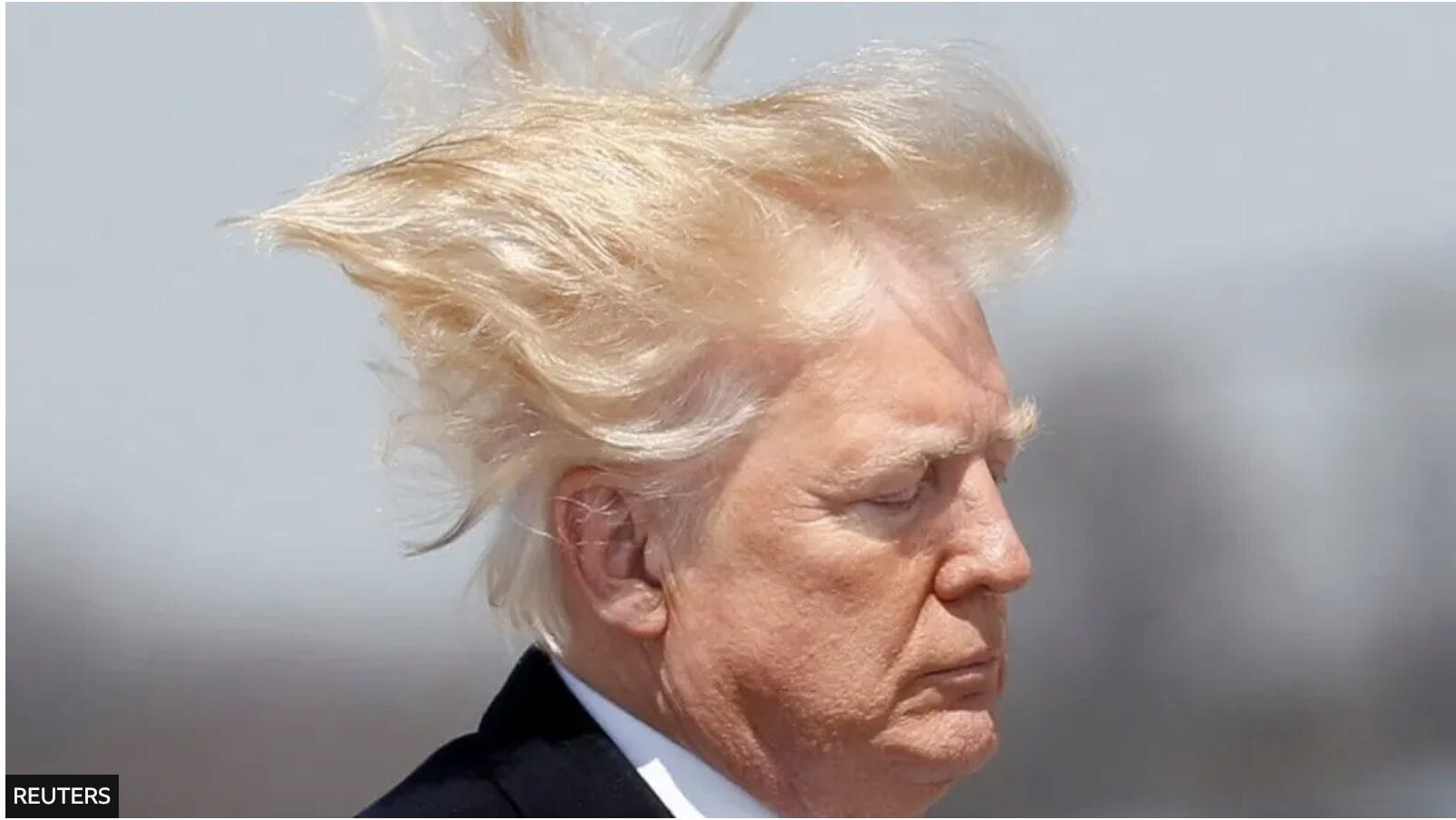Swelling after hair transplant surgery is completely normal and lasts between 3-5 days. Undergoing hair transplant surgery involves inserting the hair follicles into the scalp which stresses the local area, leading to noticeable swelling. It’s not usual to see an enlargement in the forehead, temples, and rarely the eyelids.
Understandably, people may be alarmed at their appearance. However, swelling (oedema) occurs in around 50% of cases – it’s the most common side effect of hair transplant surgery.
Still, if you’ve noticed some swelling, you might be wondering when it subsides. Below, we’re answering your questions, covering everything you need to know about swelling following a hair transplant.
How Long Does Swelling Last After Hair Transplant?
Swelling or oedema of the forehead or eyelids is a common consequence of a hair transplant. It usually develops within 2 to 6 days after the operation1. While in the majority of cases, the swelling is mild, in some patients, it’s so severe that patients cannot open their eyes.
Initially, the swelling occurs in the forehead region. Your head may appear bulbous at the top. As time progresses, the swelling can move down to the temples and eyes. It’s at this point that patient may have difficulty opening their eyes. It may also be accompanied by ecchymosis of the eyelids or slight bruising or discolouration.
Surgeons and researchers categorise swelling severity into five categories2:
- Grade 0: No swelling
- Grade I: Upper forehead swelling
- Grade II: Upper and lower forehead swelling
- Grade III: Periorbital swelling (swelling around the eyes)
- Grade IV: Black eyes
After 3-5 days, the swelling should begin to disappear. However, it might take up to a week for your face to fully return to normal. Even patients with Grade III or IV swelling will still get better without any intervention. The condition often self-resolves.
If your face does not regain its previous shape after this point, speak to your surgeon. It could be a sign of another condition or problem.
Why Does Scalp Swell After Having a Hair Transplant?
The primary cause of scalp swelling after a hair transplant is fluid retention. Oedema refers to the accumulation of fluid in the tissue. This fluid-up is only temporary and will drain away with time.
Several potential causes2,3 include:
Trauma to the Scalp
Whenever the body is injured, it is a form of trauma. The body responds by triggering its natural healing response. Inflammation occurs in the local region, including the release of fluid from the blood into the tissue. This enables white blood cells and other defences to enter the area.
As the trauma heals, the fluid naturally drains back into the fluid. While annoying, it’s part of your body’s protective measures.
Injection of Local Anaesthesia and Other Fluids
To ensure patients don’t feel pain during the procedure, a local anaesthetic (lidocaine) is injected into the scalp. Along with the anaesthetic, another fluid may also be injected into both the transplanted and donor areas to help with surgery.
This accumulation of fluid creates space between the skull and muscles, allowing for easy extraction and implantation of the hair follicles. However, in the days following the surgery, it takes time for the fluid to drain. It may move down from the forehead and into the eyelids via gravity.
Inflammation and Healing Response
Inflammation is part of the body’s healing response. Your body doesn’t know that the trauma from the hair transplant is intentional. It thinks there’s been an attack and so launches a defence to protect the scalp from potential infection.
Think about any previous injuries. Swelling is always part of the inflammatory response. You may also notice some heat, redness, and increased sensation in the affected region. All these symptoms will subside alongside the swelling.
Potential for Post-Surgical Oedema
Post-surgical oedema is a phenomenon where fluids accumulate in an area after surgery. It may be caused by the factors listed above as well as the prolonged time spent immobile. The fluid begins to accumulate in the tissues and takes a few days to resolve.
How to Prevent Swelling After a Hair Transplant
Some swelling after a hair transplant is normal – it’s not serious, and you shouldn’t worry about it. That being said, you can minimise swelling with several techniques. We recommend being patient and not trying anything drastic. But, if you want to speed up the process, consider these options:
Keep Your Head Slightly Elevated When Sleeping
Consider sleeping at a slight angle for the first few days after the operation. The higher your head is overnight, the more fluid will drain away and it often drains down the back of your head, preventing swelling at the front.
Drink Water and Eliminate Salty Foods
You might think you need to drink less. However, drinking plenty of water pushes the fluid and medicine from the surgery out of your system. If you don’t drink enough water, your body will hold onto any fluids in your system, including in your scalp. The best solution is to increase your fluid intake by drinking 2-3 big glasses of water per day.
Salty foods, on the other hand, cause the body to retain more fluid. The more fluid in your system, the slower the swelling goes down. Minimise your intake of salty foods for a few days. Eat a diet rich in lean meats, healthy fats, whole grains, fruits, and vegetables to support your recovery.
Rest and Relax
Resting is crucial. Swelling indicates your body needs time to heal and recover. Ensure you’re not stressed, take it easy, and get enough sleep. Avoid any strenuous activities that make you feel restless. Again, this is only for the first few days – although you should minimise strenuous activities for two weeks after the surgery.
Avoid Sweating
Sweating from exercise and other activities irritates the scalp. It causes blood to rush to the head, which can slow the drainage process. It also increases the infection risk. Most surgeons recommend avoiding running and vigorous exercises for at least two weeks and weightlifting for at least 1 month.
Dangers of Prolonged Swelling
Swelling alone isn’t a danger to anyone. However, if it does not begin to subside within a week of the surgery, it can indicate a more severe problem. The two biggest risks include:
Infection
Folliculitis is an inflammation or infection of the hair follicles. It can occur after a hair transplant operation. Potential infectious agents include bacteria, fungi, and viruses. You may notice:
- Red or white pimples around hair follicles
- Pus-filled blisters or crusted sores
- Itching or tenderness in the affected area
- Swelling or a burning sensation
Dealing with an infection is vital to saving the hair transplant. If the follicles are permanently damaged, it can render the transplant unsuccessful. Treatments include topical or oral antibiotics and antifungal creams.
Unsuccessful Hair Transplant
An unsuccessful hair transplant can occur if complications, such as infection or folliculitis, damage the transplanted follicles. Prolonged swelling or untreated infection may interfere with the healing process, preventing the follicles from establishing themselves in the scalp.
This can result in poor hair growth, uneven density, or, in severe cases, complete failure of the transplant. Ensuring proper aftercare, addressing any signs of infection early, and following medical advice closely are crucial to maximising the success of the procedure and achieving the desired outcome.
Book a Consultation
At The Treatment Room London, we provide FUE and FUT hair transplants tailored to address your hair loss in the hairline, crown, temples or lowering your hairline if you are female. Our expert surgeons will discuss the most suitable options for your unique hair needs and guide you through the entire process. To schedule a consultation, please complete our contact form or call us at 020 8706 0076.
References
- Nadimi S. Complications with hair transplantation. Facial Plast Surg Clin North Am. 2020 May 1;28(2):225-35.
- Gholamali A, Sepideh P, Susan E. Hair transplantation: preventing post-operative oedema. Journal of cutaneous and aesthetic surgery. 2010 May 1;3(2):87-9. Available at: https://journals.lww.com/JCAS/fulltext/2010/03020/Hair_Transplantation__Preventing_Post_operative.5.aspx
- Küçüktaş M. Complications of hair transplantation. InHair and Scalp Disorders 2017 May 3. IntechOpen.
Share:
Authored by
Reviewed by
Book a Consultation
Related Blogs
Xherdan Shaqiri Hair Transplant: Before, After, and His New Hairline
April 10, 2025
Xherdan Shaqiri is a Swiss international football star best known for his stints at Bayern Munich, Stoke…
Ariana Grande Hair Loss: Prevention, Styling Secrets, and Hypothetical Transplant Solutions
April 10, 2025
Ariana Grande, the global pop sensation renowned for her signature high ponytail and bold hairstyles, has openly…
Daniel Craig Hair Transplant: Before, After and His Hairline
April 10, 2025
Daniel Craig, the world-famous English actor who gained international fame as the fast-paced, debonair James Bond, has…
Rob Brydon Hair Transplant: Before, After, and His New Hairline
April 8, 2025
Rob Brydon, the beloved Welsh comedian and Gavin & Stacey star, has traded his receding hairline for…
Has Perez Hilton had a hair transplant? All You Need to Know
April 2, 2025
Perez Hilton is a familiar face in the media. He is known for his work as a…
Elton John and His Hair Transplant Journey
March 27, 2025
Sir Elton John has had one of the greatest careers in music. Since his rise to fame…
Steven Whittaker’s Hair Transplant – Before And After
March 25, 2025
As Hibs legend Steven Whittaker makes headlines for taking the Dunfermline player-coach role, many gazes have turned…
Donald Trump’s Hair Transplant Rumours: True Or False?
March 25, 2025
Donald Trump has long been a figure of controversy and conversation, known not only for his political…
Cesc Fàbregas Hair Transplant: Before, After and His New Hairline
March 24, 2025
Hair loss is a common concern among celebrities whose public image often plays a significant role in…











